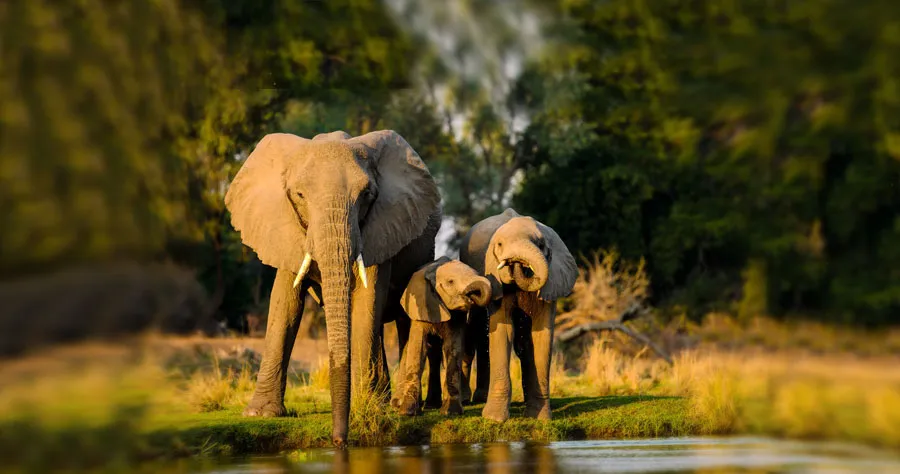For decades biologists have been puzzled by the apparent low cancer rates of elephants and other large vertebrates. After all, their size means they have more cells and therefore one would assume a higher risk of cancer. However, not only do many animals large and small get cancer significantly less than initially thought, their mechanisms to prevent the disease could benefit humans as well.
Reed McIntire
24 June 2025
French version
In 1977, biologist and statistician Sir Richard Peto observed a curious phenomenon in the natural world: cancer rates are seemingly unrelated to the number of cells in an organism’s body. Subsequently dubbed Peto’s paradox, this notion has been a topic of debate in the world of biology ever since. However, with studies emerging that dispute these findings, what can the animal kingdom tell us about cancer? And how can it be applied to humans?
In a study published in February 2025 by the scientific review PNAS, Butler et al. compared the malignancy rate, that is the rate of development of malignant tumors, across the four major categories of vertebrate animals: amphibians, birds, mammals, and squamate reptiles (snakes and lizards). Contrary to popular belief, their findings did not corroborate the notion that cancer was unrelated to body size or number of cells in an organism. In fact, elephants and large animals did get cancer at higher rates than other animals. However, this rate was still far below what was expected.
While elephants were susceptible to cancer, their malignancy rate was similar to animals only a tenth of their size, such as an ibex. A proposed reason for this is due to the genes governing these animals’ growth. Animals which need to quickly grow large in the womb, such as elephants, likely have genes which are specifically tasked with eliminating the genes governing growth, as to limit the possibility of them being hijacked by cancer. Therefore, while they are still susceptible to cancer, their cancer rates are limited due in part to this heightened control.
In another cross-species examination study which came to a similar conclusion was conducted over a 10-year period and led by researchers at Arizona State University (https://aacrjournals.org/cancerdiscovery/article/15/1/227/750844/Cancer-Prevalence-across-VertebratesCancer-across). However, what was additionally interesting were its findings on cancer rates in smaller animals. Creatures such as ferrets had an elevated risk of cancer of 62% while much larger animals like dolphins only had a cancer rate of less than 2%.
Again, the proposed rationale for this surprising conclusion goes back to the genes governing animal growth. While animals that grow large also feature genes which limit this ability, smaller animals lack these evolutionary developments meaning their growth genes can be co-opted by cancer more easily. As a result, while having significantly fewer cells in their body, smaller animals can actually suffer from extremely elevated cancer rates compared to their larger counterparts.
Furthermore, other genes that help control cancer have been identified in larger animals. In elephants, these genes are known as TP53 genes and are being investigated for possible use in therapy treatments for humans. TP53 genes are tumor suppressors, meaning they inhibit the growth and possibilities of malignant tumors developing in the bodies of elephants. If usable, these genes could help treat and suppress cancerous tumors in humans as well, thereby providing an additional tool in the fight against cancer.
Beyond TP53, the Arizona study highlighted other potential cancer defense strategies animals deploy. Species with fewer random mutations in body cells tended to have a lower prevalence of cancer. This too could have implications for human cancer treatments by suggesting that minimizing mutations through vigorous DNA protection and repair mechanisms are vital in human cancer prevention.
Interestingly, the study found that animals with longer gestation periods had lower cancer rates. According to the scientists, longer gestation might prove vital for a cell’s ability to regulate itself during the lifetime of the animal.
The researchers also tested how various species respond to cancer suppression mechanisms such as radiation and chemotherapy. These tests did not prove conclusive, suggesting that other factors such as the animals’ immune system and their metabolic processes play a more central role in their cancer resistance.
According to the American Association of Cancer Research, roughly 40% of Americans are likely to develop cancer at some point in their lifetime. However, the AACR warns that the actual rate may be higher since most deaths do not warrant an autopsy. Therefore, additional strategies and technologies which can reduce the risk of malignancy in humans remains a top medical priority. As Zach Compton, a researcher at the Arizona Cancer Evolution Center at the University of Arizona says “We are excited to harness nature’s strategies for combating cancer, to prevent it in humans.”
While genetic discoveries like TP53 may have potential in human treatments, researchers are still only scratching the surface of this field. The variation and species-specific solutions observed show there is much more to learn. Ultimately, research such as this could provide life-saving treatments and therapies in the future, but there is much more to learn before any major advances can be found.






















